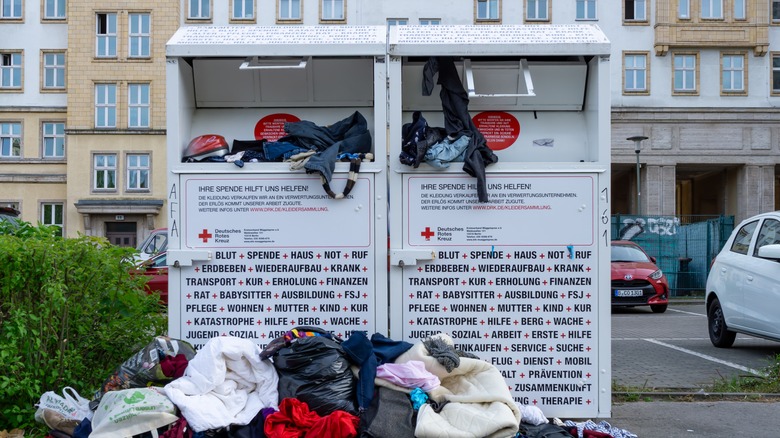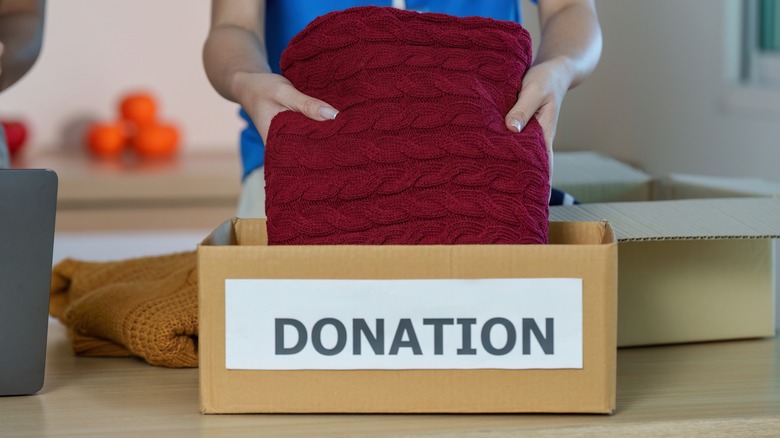This TikToker Used An AirTag To Track His Donated Shoes And Discovered Where They Really Ended Up
These days, smart trackers have become ubiquitous in our lives, whether it's to track our valuable electronics to even our everyday items like wallets or car keys. Among popular smart trackers in the market, the AirTag is one of the top choices for a lot of people, especially those already invested in the Apple ecosystem. Using the tech giant's proprietary technology AirTags are designed to track objects using a web of existing Apple devices in the wild and their Find My app. And while people have used AirTags for unconventional ways, such as tracking pets or even children, one person decided to use it for an unconventional experiment: finding out where our donations go.
In a viral video, German TikTok influencer @moe.haa shared the fascinating journey of his donated shoes from Germany to Bosnia. The original video is no longer there, but it was reposted to YouTube. Originally donated to the German Red Cross, Moe tracked their pair of shoes using a carefully hidden AirTag through a 5-day cross-country journey across Europe. Afterward, he visited the store itself, citing how the staff refuted that they were selling donated items.
While thousands of netizens expressed a mix of emotions, including surprise and outrage, the German Red Cross has always been transparent about its operations. Among the wearable donations it receives, it states that about 10% go to the actual people in need on average, while the rest are sold. Here's why this happens, the reasons why many donation-based groups do the same, and what to do instead if this doesn't resonate with you.
Why this isn't as wild as people think
In the past, groups like Goodwill have issued requests for people to stop donating junk, such as items that are worn out, expensive to repair, and can't be used. In fact, the German Red Cross specifically mentions that only half of its collections are considered wearable. In many cases, even people who mean well may not realize that their beloved donations aren't fit for other people's use. Not to mention, Goodwill shared that bad donation practices, like leaving things outdoors, can lead to damage. Typically, donation centers often have to sift through tons of items and even shoulder the cost of sending them to landfills or electronic recycling facilities where they have the technology to extract the metals.
For large non-profits, they also needs to make sure its operations are sustainable. Typically, they often employ volunteer or full-time staff, who may need compensation for their help. In some cases, they also pay for management of physical locations, where people can drop off goods. Because of this, it can sometimes be more effective for them to sell the donated items, especially ones that can fetch a good price, to be able to generate the cash necessary to continue to do their work. While the Red Cross sends used clothing during acute disaster areas, it mentions the impact of shipping used clothes to distant places. Apart from the cost of fuel for the trucks or flights, it factors in the environmental impact.
Are there better ways to help?
In reality, what non-profits do with our donated items is up to their discretion. Depending on the group, the scope of people who will receive their benefits can span communities to continents. It's important to note that just because your items ended up in a resale store, it doesn't mean it didn't contribute to the system that helps people. But if you don't like the idea of your used personal items ending up on a shelf somewhere instead of with someone in need, there are other ways you can help.
For example, if you have recently upgraded your smart home assistants, you can follow Google's lead and donate them directly to foundations who cater to people that are paralyzed. If you're a handy person, you can offer to repair broken electronics from thrift stores and make sure they end up in the hands of people who will actually use them. In some cases, donating specific items like well-maintained books to schools or libraries, who have a constant need for them, might be a better idea. You can also opt to sell your used power tools on places like Craigslist, Facebook Marketplace, OfferUp, or eBay, and give money directly to your local charities. Alternatively, if you're particular about where your donations go, you can opt to give back in the form of cash. For example, you can create fundraisers via Instagram Reels and help create a fund for scholarships or specific initiatives in your neighborhood.


